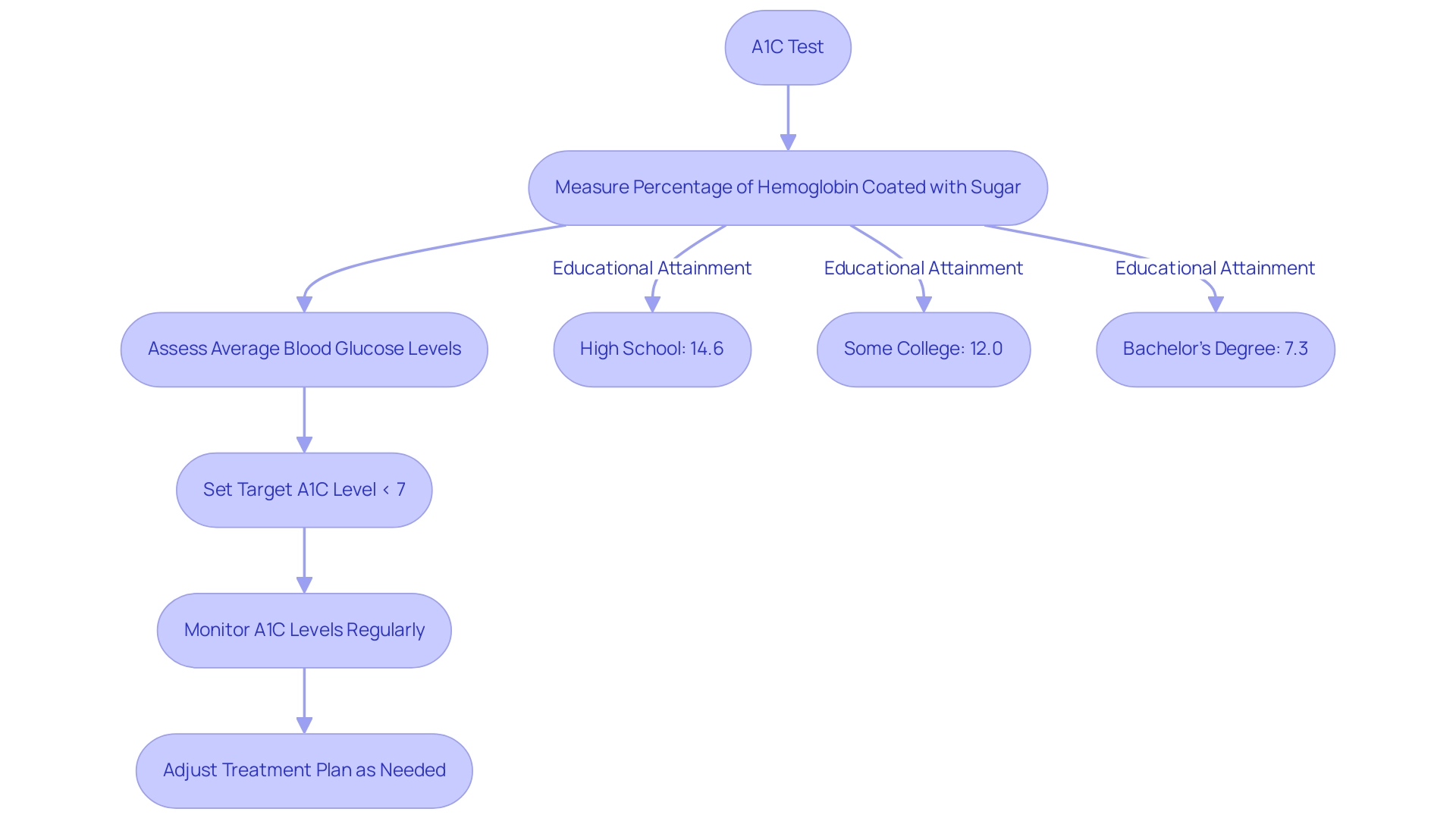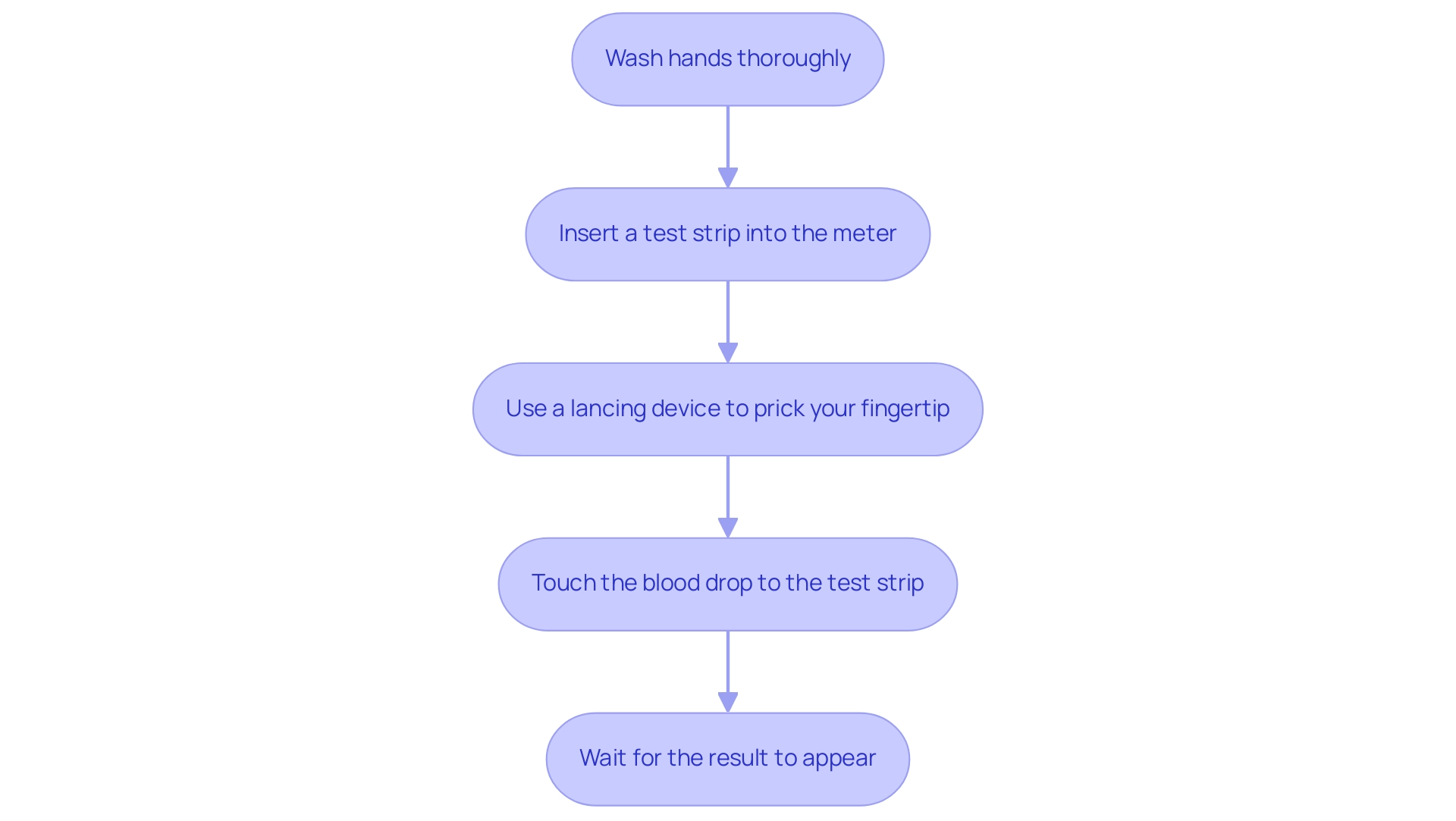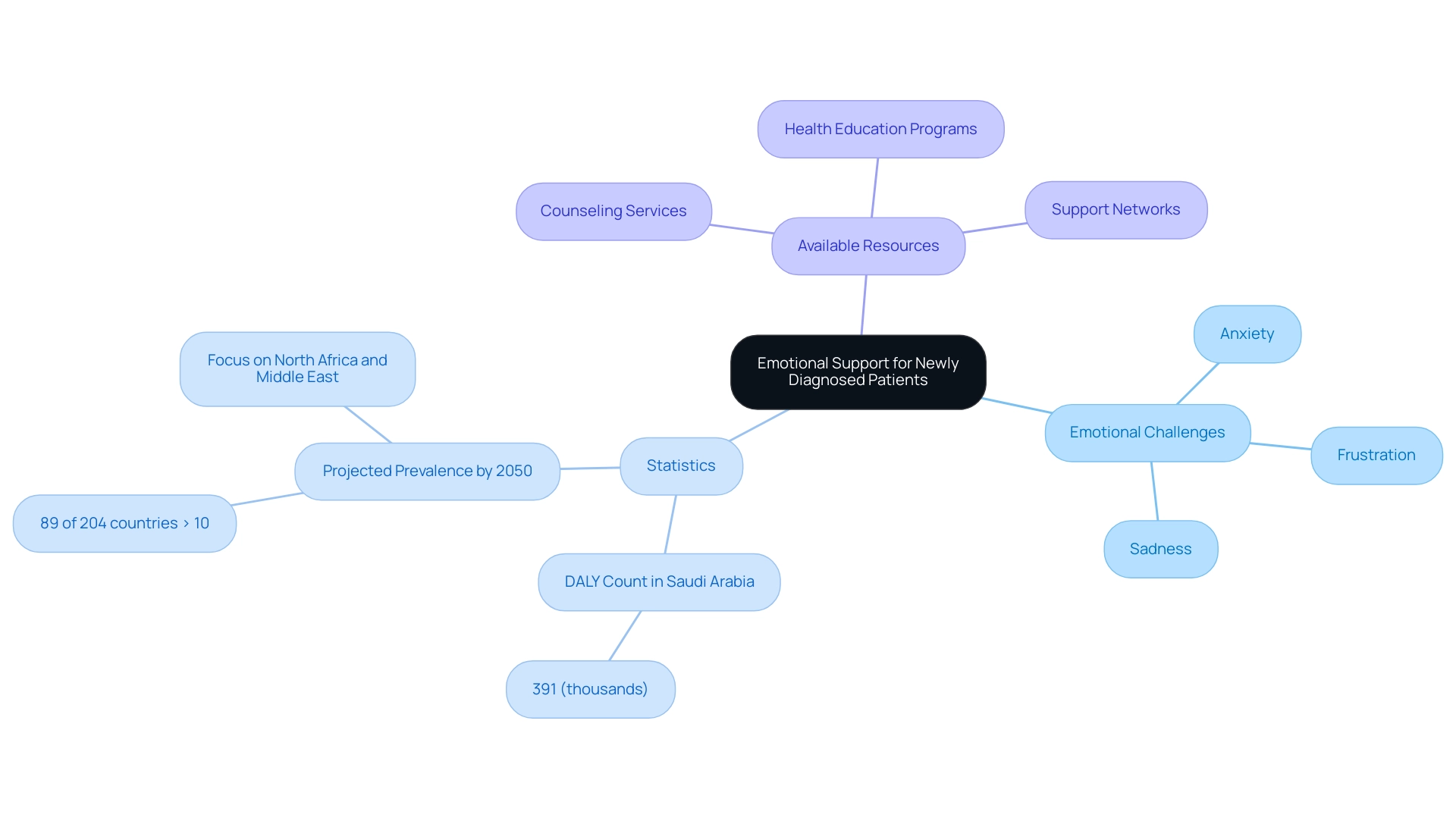Overview
This article explores how to effectively use a glucose conversion chart to manage diabetes, highlighting the importance of understanding blood sugar levels expressed in different units. It's crucial to grasp how these measurements affect your health, and we’re here to guide you through this process. The straightforward conversion between mg/dL and mmol/L is explained, making it easier for you to navigate your readings. Remember, accurate monitoring is essential, and education plays a vital role in enhancing your diabetes management and communication with healthcare providers. You're not alone in this journey; we are here to support you every step of the way.
Introduction
Navigating the complexities of diabetes management can feel overwhelming, especially for those who have recently received a diagnosis. As diabetes continues to affect more individuals, it becomes crucial to understand key aspects such as:
- Blood glucose levels
- A1C testing
- Effective self-monitoring
T2DSolutions stands out as a vital resource hub, dedicated to providing education and support for individuals grappling with Type 2 and Type 3 diabetes. By mastering glucose conversions and utilizing monitoring tools effectively, patients can discover essential strategies that empower them to take control of their health.
Remember, you’re not alone in this journey. Emotional support and community connections play a significant role in fostering resilience during these challenging times, and together, we can navigate this path.
Understanding Glucose Conversion: The Basics
As T2DSolutions launches as a new resource hub for Type 2 and Type 3 blood sugar education and community support, it’s essential for newly diagnosed patients to understand blood sugar levels. These levels are primarily expressed in two units: milligrams per deciliter (mg/dL) and millimoles per liter (mmol/L). It’s understandable to feel overwhelmed by these numbers, but the conversion between these units is straightforward: to convert mg/dL to mmol/L, simply divide the value by 18, and to convert mmol/L to mg/dL, multiply by 18.
Mastering these conversions using a glucose conversion chart is crucial for accurately interpreting blood sugar readings, especially when using various monitoring devices or adhering to different healthcare standards. For instance, a blood sugar measurement of 180 mg/dL translates to 10 mmol/L when divided by 18. This understanding not only facilitates effective communication with your healthcare team but also empowers you to make informed decisions regarding your condition management by using a glucose conversion chart.
With the prevalence of blood sugar disorders increasing, especially among young people—5,293 children and teenagers aged 10 to 19 were identified with type 2 conditions in 2017–2018—the importance of precise monitoring cannot be emphasized enough. You are not alone in this journey; many are navigating similar challenges. Additionally, as part of its commitment to education on this condition, T2DSolutions will provide insights on recent updates, such as the American Diabetes Association's revised preprandial glycemic target from 70–130 mg/dL to 80–130 mg/dL in 2015, aiming to reduce overtreatment. Research by Hermanns et al. has highlighted the essential function of continuous glucose monitoring in improving hypoglycemia control, further stressing the necessity for accurate glucose level measurements.
At T2DSolutions, we are here to support you every step of the way. We are committed to providing available materials to assist you in navigating blood sugar control efficiently. To stay updated on the latest resources and insights, we encourage you to subscribe for email notifications about new content as we grow our community together.

The Role of A1C in Diabetes Management
The A1C test serves as a vital tool in managing blood sugar levels, measuring the percentage of hemoglobin in your blood that is coated with sugar. This percentage reflects your average blood glucose levels over the past two to three months, offering a comprehensive view of your glycemic control. For many adults with this condition, a target A1C level is set below 7%.
This benchmark is supported by the latest guidelines, which emphasize that maintaining an optimal A1C level is crucial for reducing the risk of complications related to diabetes. It's important to note that the prevalence of diagnosed conditions related to blood sugar has decreased from 14.6% in adults with a high school degree, GED, or less, to 12.0% in those with some college education, and further to 7.3% in adults with a bachelor’s degree or more. This highlights the significance of A1C testing in relation to educational attainment. To make A1C results more accessible, you can use the glucose conversion chart with the formula:
eAG (mg/dL) = 28.7 × A1C - 46.7
For instance, according to the glucose conversion chart, an A1C of 7% corresponds to an estimated average glucose (eAG) of approximately 154 mg/dL. Regularly monitoring your A1C levels is essential, as it allows you to assess the effectiveness of your current treatment plan and make any necessary adjustments. At T2DSolutions, we aim to support newly diagnosed patients by providing educational resources that help interpret A1C results and understand their implications for managing their condition.
According to a case study titled 'Trends in Diabetes Prevalence Over Time,' the age-adjusted prevalence of total metabolic disorders increased from 9.7% in 1999–2000 to 14.3% in August 2021–August 2023. This underscores the growing public health concern regarding these disorders in the U.S. Experts recommend regular testing, especially for individuals with risk factors, as screening for this condition in asymptomatic people with extra risk factors is advised. This approach highlights the importance of the A1C test in creating personalized treatment strategies and enhancing health outcomes—a focus that T2D Solutions is dedicated to promoting through its information hub.

How to Use Glucose Conversion Charts Effectively
Using a glucose conversion chart effectively is essential for managing blood sugar levels, especially for those who have recently received a diagnosis. At T2DSolutions, we understand how overwhelming this journey can be, and we are committed to providing comprehensive resources to support you every step of the way. Begin by identifying the unit of measurement for your blood sugar reading—if your reading is in mg/dL but you need it in mmol/L, our chart is here to help you find the corresponding value.
For instance, a reading of 120 mg/dL converts to approximately 6.7 mmol/L. We encourage you to keep a printed copy of this conversion chart handy for quick reference, particularly during medical appointments or discussions with your healthcare providers. Familiarity with these charts not only boosts your confidence but also empowers you to engage in informed conversations about your health.
Recent studies have shown that structured monitoring tools, like Continuous Glucose Monitoring (CGM) devices, can lead to significant improvements in glycemic control, with a notable decrease in blood sugar variability of −3.09% (95% CI −4.43 to −1.74). As internal medicine expert Andre E Manov states, 'Our study demonstrates that CGM devices lead to significant improvements in glycemic control in comparison to SMBG.' This highlights how incorporating various metrics, including those from a glucose conversion chart, can support thorough control of blood sugar levels and reduce complications.
Moreover, the rise in type 2 diabetes among all racial and ethnic groups from 2002 to 2018 underscores the urgent need for effective strategies to address this health issue. Establishing a consistent practice of using these charts can reinforce your oversight strategy and support your overall health outcomes. At A2D Solutions, we invite you to subscribe for updates to ensure you have the information and assistance needed for your health journey. Remember, you're not alone in this journey; we are here to support you every step of the way.

The Importance of Self-Monitoring Blood Glucose Levels
Self-monitoring of blood sugar (SMBG) is an essential practice for anyone managing their condition, empowering individuals to take control of their health. At T2DSolutions, we strive to be your all-encompassing resource for Type 2 and Type 3 blood sugar control, offering vital education and community assistance customized to your requirements. Consistently monitoring blood sugar levels with a meter enables prompt changes in treatment.
To effectively perform SMBG, follow these steps:
- Wash your hands thoroughly to ensure cleanliness.
- Insert a test strip into your meter, ensuring it is ready for use.
- Utilize a lancing device to prick the side of your fingertip, obtaining a small drop of blood.
- Touch the blood drop to the test strip and wait for the result to appear.
Aim to check your blood sugar levels at various times throughout the day, ideally before meals and at bedtime. Keeping a log of your readings is essential; it helps identify patterns and allows for necessary adjustments to your treatment plan, which can be informed by a glucose conversion chart. Statistics reveal that the odds of maintaining good SMBG practices are significantly lower for those who lack proper education—specifically, individuals not taught SMBG techniques show an adjusted odds ratio of 0.122 (95% CI = 0.044–0.338).
This highlights the critical role education plays in effective self-monitoring and adherence to SMBG practices. Moreover, as B. Gurney mentions, 'Productive workplaces start with, and are maintained by, a careful blend of individual worker skill and self-assurance along with the appropriate tools,' which can also be applied to the management of blood sugar conditions. A recent study titled 'Impact of Technology on SMBG Adherence' noted that advancements in glucose monitoring technology could enhance adherence to SMBG recommendations, particularly as the availability of continuous glucose monitoring (CGM) and flash glucose monitoring (FGM) devices improves.
At T2Solutions, we are committed to providing you with educational materials, tools, and community programs that enhance your SMBG practices. By adhering to these steps and grasping the importance of SMBG, individuals can significantly enhance their health outcomes, and T2Solutions is here to assist you throughout the process. Remember, you're not alone in this journey; we are here to support you every step of the way.

Emotional Support and Resources for Newly Diagnosed Patients
Receiving a diagnosis of this condition can be profoundly overwhelming, often accompanied by a range of emotions, including anxiety, frustration, and sadness. It’s completely understandable to feel this way, and acknowledging these feelings is an important step in your journey. T2DSolutions, an innovative support center focused on Type 2 and Type 3 blood sugar regulation, is here to empower you with extensive materials designed to ease these challenges.
You can subscribe to our updates to stay informed about new content and resources as they become available. Recent statistics indicate that the Disability-Adjusted Life Years (DALY) count in Saudi Arabia was 391 (thousands), highlighting the significant impact of this condition on public health. Connecting with others who understand your challenges can be incredibly beneficial; joining a support group—whether in-person or online—enables you to share experiences and cope collectively.
Furthermore, a case study projected that by 2050, 89 of 204 countries will have an age-standardized prevalence rate for the condition greater than 10%, particularly in North Africa and the Middle East. This indicates a growing public health concern and the necessity for support systems. T2D Solutions is dedicated to offering access to diverse materials, such as:
- Counseling services
- Health education programs
- Support networks customized to your needs
It is advisable to reach out to your healthcare team for recommendations on local resources.
As psychologist S.U. aptly stated, "Emotional support is crucial for individuals managing chronic conditions, as it fosters resilience and coping strategies." Remember, you are not alone. Ample support exists through T2D Solutions to help you navigate the complexities of managing diabetes, making the journey more manageable and less isolating.

Conclusion
Understanding diabetes management involves mastering key concepts such as glucose conversions, A1C testing, and self-monitoring. At T2DSolutions, we serve as a vital resource hub, offering education and support to those navigating the challenges of Type 2 and Type 3 diabetes. By grasping the importance of accurate blood glucose readings and effectively utilizing glucose conversion charts, you can engage more meaningfully with your healthcare team and make informed decisions about your treatment plan.
The A1C test is another cornerstone of diabetes management, providing insights into long-term blood sugar control. Regular monitoring of A1C levels allows you to assess the effectiveness of your diabetes management strategies and adjust them accordingly. With the rise in diabetes prevalence, understanding these metrics becomes increasingly crucial to prevent complications and ensure optimal health outcomes.
Self-monitoring blood glucose levels is an empowering practice that fosters independence and better health management. By adopting consistent self-monitoring routines and utilizing available educational resources, you can enhance your understanding of diabetes and improve your overall glycemic control.
Emotional support is equally important in this journey. Connecting with others facing similar challenges can alleviate feelings of isolation and anxiety. At T2DSolutions, we emphasize the significance of community connections and emotional well-being, ensuring that you do not have to navigate your diabetes journey alone.
In conclusion, embracing education, effective monitoring practices, and emotional support can transform your diabetes management experience. T2DSolutions is dedicated to providing the resources and community necessary for you to thrive, reinforcing that with the right tools and support, it is possible to take control of diabetes and lead a fulfilling life.



